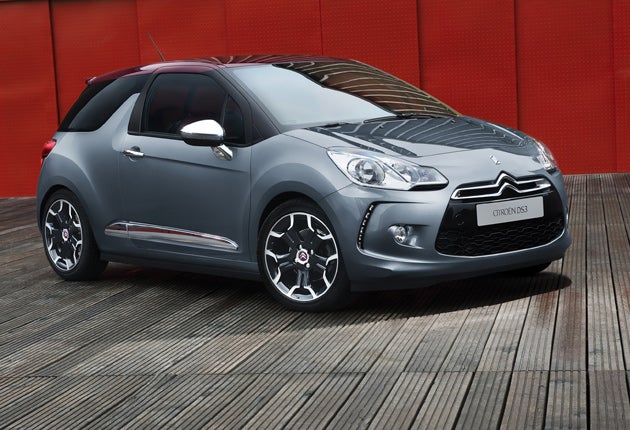Citroën DS3
They brought you iconic designs in the Forties and Fifties, and they're at it again with the first in the new DS range

Citroën. A brand more complicated than it might first appear. Depending on your age and car knowledge, the starting point in your Citroën perception may be, like mine, a notion of strange and fantastic ways of creating popular cars unlike any others. Who else could make a car like a streamlined, hydro-pneumatically sprung DS, a wheel-at-each-corner Traction Avant, or a tin-snail CV?
But I am basking in a rosy past, before rampant safety and emissions legislation forced all car-makers into design and engineering straitjackets. Besides, there has always been the need to make money. That is why some of the heart was torn out of Citroën during the past quarter-century, as its Peugeot parent placed sales success above idiosyncratic engineering and the style that went with it.
You can't blame Peugeot for wanting to make Citroën a paying proposition, but it's a shame the past was so decisively denied when it is that past which gave Citroë*its reason to exist. Instead, Citroën became a bargain brand, sullied – particularly in the UK – by a rampant discount culture which traded long-term respect for short-term gain. Inevitably, recent attempts to break out of this – with some terrific concept cars and the splendid C6 – have still to take root.
So, meet Citroën's new DS. This time it's a range, a sub-brand, a new concept in Citroënism rather than just one car. It arrives as Citroën re-embraces its past, but this is not retro-flavoured in the mould of a Mini or a Beetle. It is instead a more luxurious, more indulgent, more heart-warming alternative to mainstream Citroëns.
There will be DS4 and DS5 models, but first, please meet the DS3. Based on the recently-launched C3 super-mini, and vying for buyers tempted also by a Mini or an Alfa Mito, it's a pert-looking, three-door hatchback whose blade-like roof apes the Mini's but whose "shark's fin" centre pillar – which seemingly leaves fresh air between the fin and the roof – is entirely its own.
As with the Mini, the roof can be had in a contrasting colour, and there's a range of patterns and stripes and bright-metal accessorisations to personalise your DS3. Same with the interior; the dashboard is based on the C3's but you can cover it with leather (even in a quilt effect, if you must) or have a large section of it painted in one of the body colours.
For my DS3 "experience" I selected a DSport model in metallic grey with roof, dashboard and interior leather in a rich, dark red. (Less lush versions are called DSign and DStyle.) Dispassionate examination revealed the bonnet, front wings and windscreen to be shared with the C3 but you would barely notice. The whole aura is different: the idea has been to make a car which is truly fun to drive, and these are not empty words. DS3 project leader Thierry Blanchard knows well how keen drivers have despaired of the Peugeot-Citroën group's loss of what once made its hot hatchbacks among the very best for driving amusement. He says the DS3 rights the recent wrongs.
Specifically, its steering is freed of the rubberiness and artificial stiffness that spoils the racier versions of the Peugeot 207, from which the DS3's underskin architecture has evolved. And its rear suspension's rubber pivots contain both soft and hard layers, to damp out road harshness without spoiling the precision. The engineers have listened and learned. "The DS3 feels like a more grown-up Saxo VTS," says Blanchard. Which sounds like good news.
He's right, too. The steering is precise, ideally weighted, and free of the glutinous action that plagues some similar electric systems. The DS3 copes well with bumps, letting you know they are there but spiriting the aftershock away. Out on the open road it points keenly into corners, just as that Saxo VTS and its fabulous forbear, the Peugeot 205 GTI, once did, but the tail always stays well tied down. You can turn the traction and stability controls off for more amusement, but even when switched on they don't cool your ardour too often.
The £15,900 DSport I'm driving has the 154bhp version of the turbocharged, direct-injection engine used in some other Peugeots, Citroëns and the Mini Cooper S – lesser petrol and diesel engines are also available – and it's as smooth and punchy as ever. Overtaking is the matter of an ankle-flex, there is no detectable response lag from the turbocharger, and in the DS3 it has an exhaust note deep and sonorous enough to set the right aural backdrop. All the fun of a Mini, with a better ride and a bigger boot, to boot.
Thumbs up all round, then. The DS brand gets off to a credible start. The DS3 looks good, feels good and is great fun to drive. Best of all, Peugeot-Citroën's engineers have got their fun-car mojo back.
The Rivals
Mini Cooper S: from £16,575
More powerful (175bhp) version of engine used in DS3 makes Cooper S very lively, but the ride can get tiresomely bumpy, and the boot is tiny.
Fiat 500 Abarth: £13,605
Smaller, cheaper, but similar feisty turbo (135bhp). Suspension changes make the Abarth the most comfortable 500, as well as the most fun.
Alfa Mito Quadrifoglio Verde: £16,000
Multiair engines feature hydraulic inlet valves; top model gets 170bhp and low CO2 from 1.4 litres. Steering improved. Looks fun, and is.
Join our commenting forum
Join thought-provoking conversations, follow other Independent readers and see their replies
Comments
Bookmark popover
Removed from bookmarks